Organisational Behaviour: Analysis of Managerial Issues and Strategies
VerifiedAdded on 2020/05/16
|8
|2007
|56
Essay
AI Summary
This essay delves into the realm of organizational behaviour, meticulously examining prevalent managerial issues within organizational settings. It explores critical aspects such as job satisfaction, employee motivation, reward systems, goal setting, and the overall workplace environment. The essay investigates the interconnectedness of these issues and how their continuity affects organizational dynamics. It highlights the importance of managers addressing these issues, providing examples of successful mitigation strategies. The essay emphasizes the need for managers to understand and implement strategies that foster employee engagement, job satisfaction, and a positive work environment. The essay also references Maslow's hierarchy of needs as a framework for understanding employee motivation and suggests a holistic approach to management that considers both individual and organizational needs, ultimately aiming to enhance productivity and reduce employee turnover.
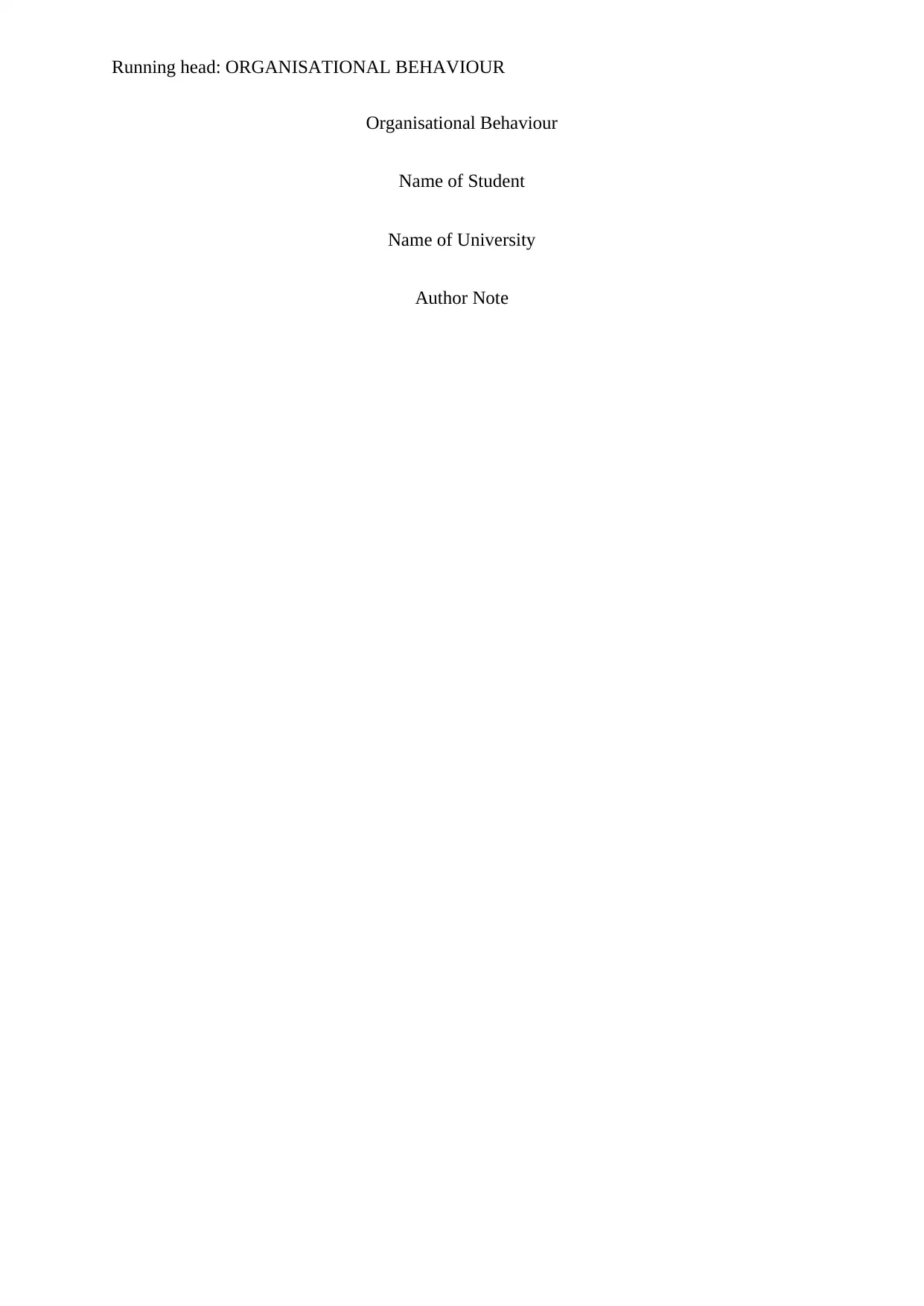
Running head: ORGANISATIONAL BEHAVIOUR
Organisational Behaviour
Name of Student
Name of University
Author Note
Organisational Behaviour
Name of Student
Name of University
Author Note
Secure Best Marks with AI Grader
Need help grading? Try our AI Grader for instant feedback on your assignments.
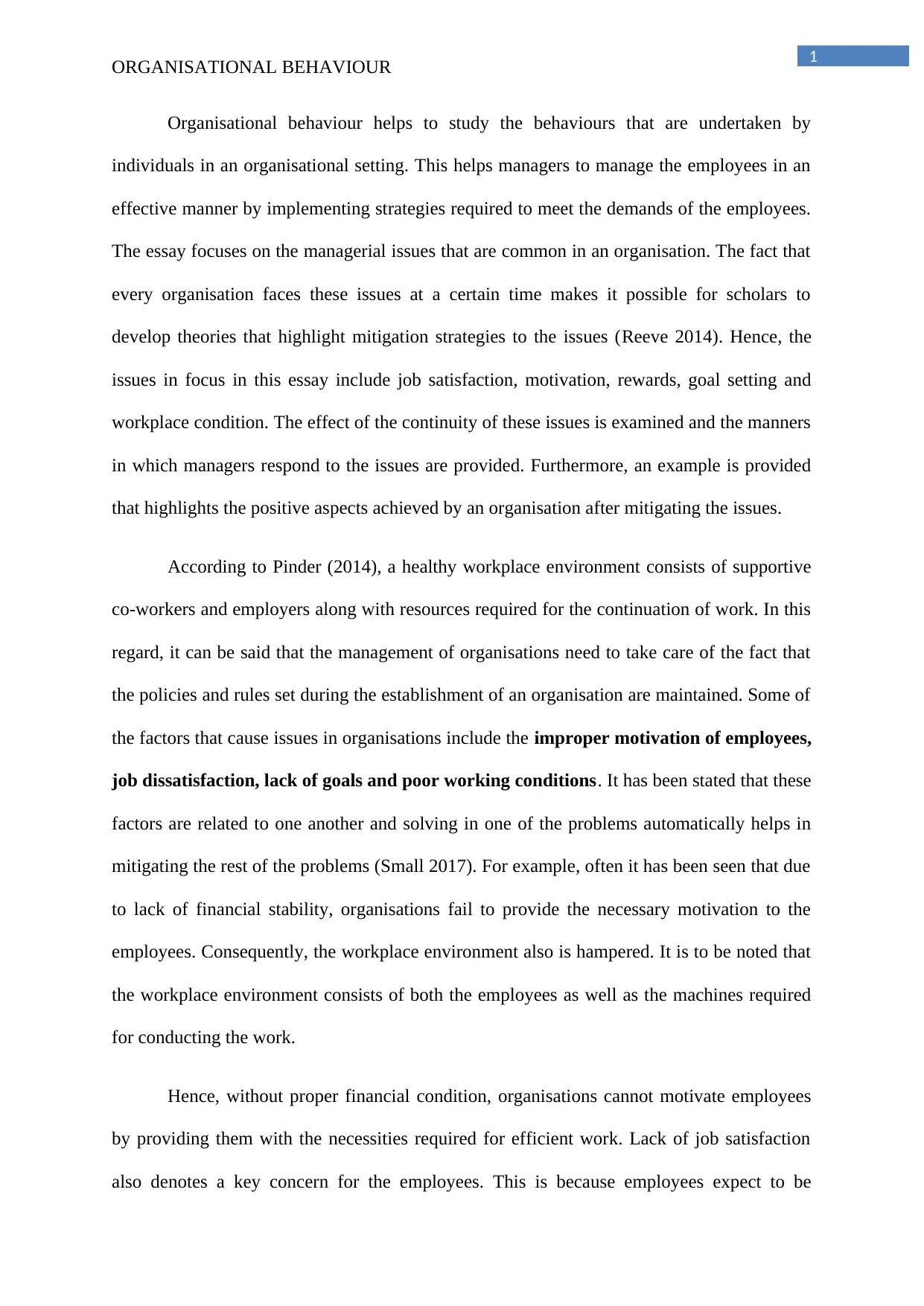
1
ORGANISATIONAL BEHAVIOUR
Organisational behaviour helps to study the behaviours that are undertaken by
individuals in an organisational setting. This helps managers to manage the employees in an
effective manner by implementing strategies required to meet the demands of the employees.
The essay focuses on the managerial issues that are common in an organisation. The fact that
every organisation faces these issues at a certain time makes it possible for scholars to
develop theories that highlight mitigation strategies to the issues (Reeve 2014). Hence, the
issues in focus in this essay include job satisfaction, motivation, rewards, goal setting and
workplace condition. The effect of the continuity of these issues is examined and the manners
in which managers respond to the issues are provided. Furthermore, an example is provided
that highlights the positive aspects achieved by an organisation after mitigating the issues.
According to Pinder (2014), a healthy workplace environment consists of supportive
co-workers and employers along with resources required for the continuation of work. In this
regard, it can be said that the management of organisations need to take care of the fact that
the policies and rules set during the establishment of an organisation are maintained. Some of
the factors that cause issues in organisations include the improper motivation of employees,
job dissatisfaction, lack of goals and poor working conditions. It has been stated that these
factors are related to one another and solving in one of the problems automatically helps in
mitigating the rest of the problems (Small 2017). For example, often it has been seen that due
to lack of financial stability, organisations fail to provide the necessary motivation to the
employees. Consequently, the workplace environment also is hampered. It is to be noted that
the workplace environment consists of both the employees as well as the machines required
for conducting the work.
Hence, without proper financial condition, organisations cannot motivate employees
by providing them with the necessities required for efficient work. Lack of job satisfaction
also denotes a key concern for the employees. This is because employees expect to be
ORGANISATIONAL BEHAVIOUR
Organisational behaviour helps to study the behaviours that are undertaken by
individuals in an organisational setting. This helps managers to manage the employees in an
effective manner by implementing strategies required to meet the demands of the employees.
The essay focuses on the managerial issues that are common in an organisation. The fact that
every organisation faces these issues at a certain time makes it possible for scholars to
develop theories that highlight mitigation strategies to the issues (Reeve 2014). Hence, the
issues in focus in this essay include job satisfaction, motivation, rewards, goal setting and
workplace condition. The effect of the continuity of these issues is examined and the manners
in which managers respond to the issues are provided. Furthermore, an example is provided
that highlights the positive aspects achieved by an organisation after mitigating the issues.
According to Pinder (2014), a healthy workplace environment consists of supportive
co-workers and employers along with resources required for the continuation of work. In this
regard, it can be said that the management of organisations need to take care of the fact that
the policies and rules set during the establishment of an organisation are maintained. Some of
the factors that cause issues in organisations include the improper motivation of employees,
job dissatisfaction, lack of goals and poor working conditions. It has been stated that these
factors are related to one another and solving in one of the problems automatically helps in
mitigating the rest of the problems (Small 2017). For example, often it has been seen that due
to lack of financial stability, organisations fail to provide the necessary motivation to the
employees. Consequently, the workplace environment also is hampered. It is to be noted that
the workplace environment consists of both the employees as well as the machines required
for conducting the work.
Hence, without proper financial condition, organisations cannot motivate employees
by providing them with the necessities required for efficient work. Lack of job satisfaction
also denotes a key concern for the employees. This is because employees expect to be
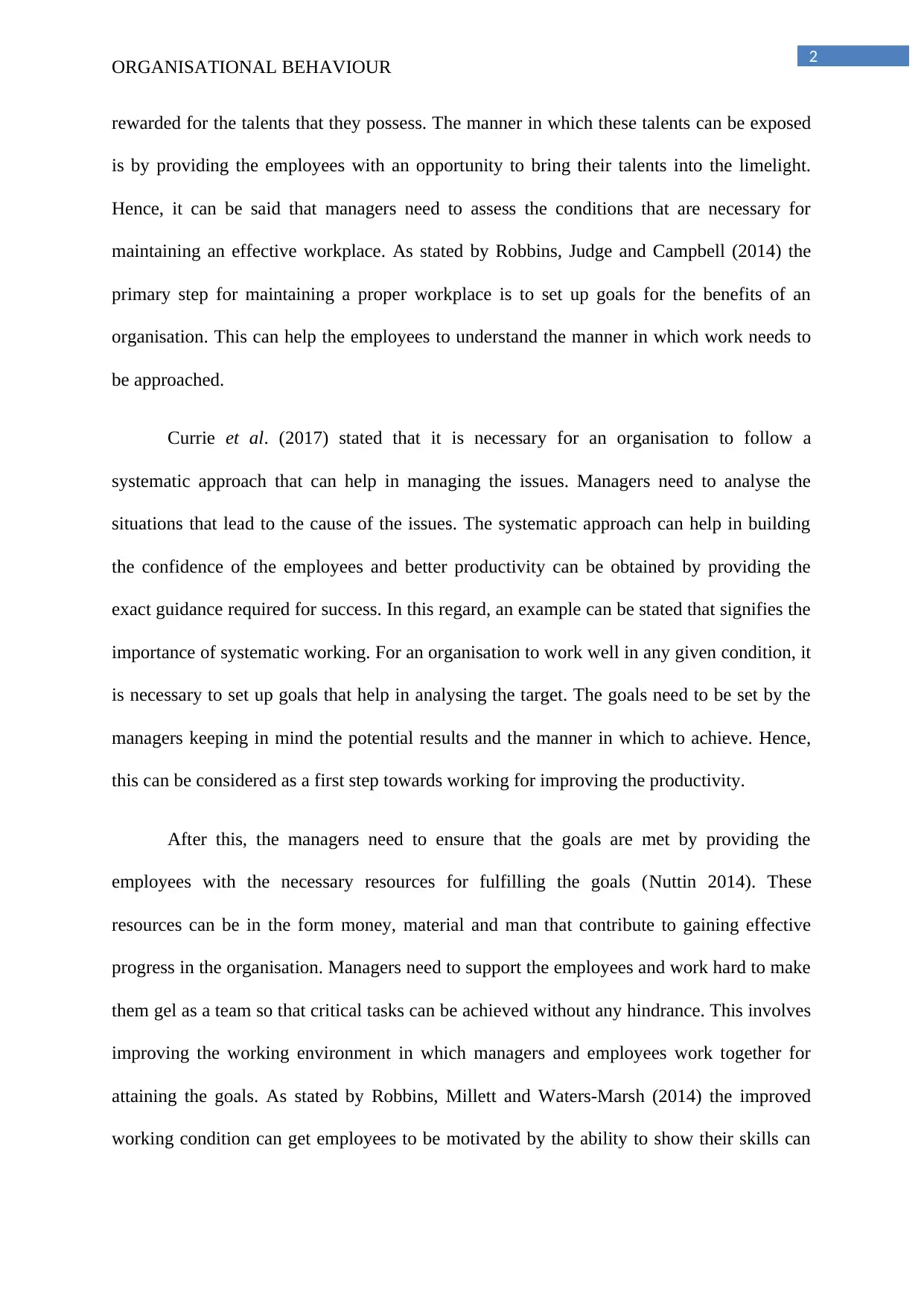
2
ORGANISATIONAL BEHAVIOUR
rewarded for the talents that they possess. The manner in which these talents can be exposed
is by providing the employees with an opportunity to bring their talents into the limelight.
Hence, it can be said that managers need to assess the conditions that are necessary for
maintaining an effective workplace. As stated by Robbins, Judge and Campbell (2014) the
primary step for maintaining a proper workplace is to set up goals for the benefits of an
organisation. This can help the employees to understand the manner in which work needs to
be approached.
Currie et al. (2017) stated that it is necessary for an organisation to follow a
systematic approach that can help in managing the issues. Managers need to analyse the
situations that lead to the cause of the issues. The systematic approach can help in building
the confidence of the employees and better productivity can be obtained by providing the
exact guidance required for success. In this regard, an example can be stated that signifies the
importance of systematic working. For an organisation to work well in any given condition, it
is necessary to set up goals that help in analysing the target. The goals need to be set by the
managers keeping in mind the potential results and the manner in which to achieve. Hence,
this can be considered as a first step towards working for improving the productivity.
After this, the managers need to ensure that the goals are met by providing the
employees with the necessary resources for fulfilling the goals (Nuttin 2014). These
resources can be in the form money, material and man that contribute to gaining effective
progress in the organisation. Managers need to support the employees and work hard to make
them gel as a team so that critical tasks can be achieved without any hindrance. This involves
improving the working environment in which managers and employees work together for
attaining the goals. As stated by Robbins, Millett and Waters-Marsh (2014) the improved
working condition can get employees to be motivated by the ability to show their skills can
ORGANISATIONAL BEHAVIOUR
rewarded for the talents that they possess. The manner in which these talents can be exposed
is by providing the employees with an opportunity to bring their talents into the limelight.
Hence, it can be said that managers need to assess the conditions that are necessary for
maintaining an effective workplace. As stated by Robbins, Judge and Campbell (2014) the
primary step for maintaining a proper workplace is to set up goals for the benefits of an
organisation. This can help the employees to understand the manner in which work needs to
be approached.
Currie et al. (2017) stated that it is necessary for an organisation to follow a
systematic approach that can help in managing the issues. Managers need to analyse the
situations that lead to the cause of the issues. The systematic approach can help in building
the confidence of the employees and better productivity can be obtained by providing the
exact guidance required for success. In this regard, an example can be stated that signifies the
importance of systematic working. For an organisation to work well in any given condition, it
is necessary to set up goals that help in analysing the target. The goals need to be set by the
managers keeping in mind the potential results and the manner in which to achieve. Hence,
this can be considered as a first step towards working for improving the productivity.
After this, the managers need to ensure that the goals are met by providing the
employees with the necessary resources for fulfilling the goals (Nuttin 2014). These
resources can be in the form money, material and man that contribute to gaining effective
progress in the organisation. Managers need to support the employees and work hard to make
them gel as a team so that critical tasks can be achieved without any hindrance. This involves
improving the working environment in which managers and employees work together for
attaining the goals. As stated by Robbins, Millett and Waters-Marsh (2014) the improved
working condition can get employees to be motivated by the ability to show their skills can
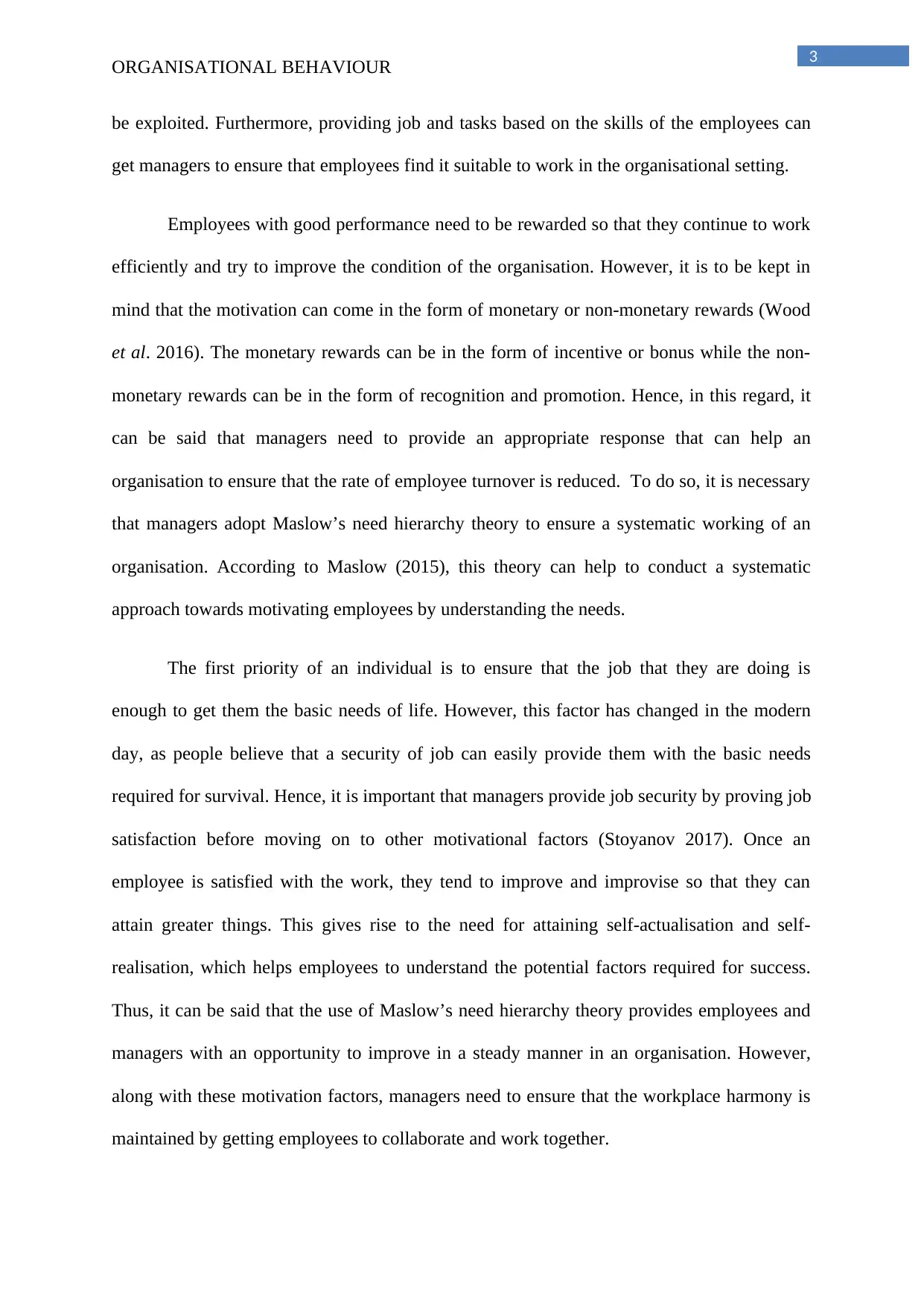
3
ORGANISATIONAL BEHAVIOUR
be exploited. Furthermore, providing job and tasks based on the skills of the employees can
get managers to ensure that employees find it suitable to work in the organisational setting.
Employees with good performance need to be rewarded so that they continue to work
efficiently and try to improve the condition of the organisation. However, it is to be kept in
mind that the motivation can come in the form of monetary or non-monetary rewards (Wood
et al. 2016). The monetary rewards can be in the form of incentive or bonus while the non-
monetary rewards can be in the form of recognition and promotion. Hence, in this regard, it
can be said that managers need to provide an appropriate response that can help an
organisation to ensure that the rate of employee turnover is reduced. To do so, it is necessary
that managers adopt Maslow’s need hierarchy theory to ensure a systematic working of an
organisation. According to Maslow (2015), this theory can help to conduct a systematic
approach towards motivating employees by understanding the needs.
The first priority of an individual is to ensure that the job that they are doing is
enough to get them the basic needs of life. However, this factor has changed in the modern
day, as people believe that a security of job can easily provide them with the basic needs
required for survival. Hence, it is important that managers provide job security by proving job
satisfaction before moving on to other motivational factors (Stoyanov 2017). Once an
employee is satisfied with the work, they tend to improve and improvise so that they can
attain greater things. This gives rise to the need for attaining self-actualisation and self-
realisation, which helps employees to understand the potential factors required for success.
Thus, it can be said that the use of Maslow’s need hierarchy theory provides employees and
managers with an opportunity to improve in a steady manner in an organisation. However,
along with these motivation factors, managers need to ensure that the workplace harmony is
maintained by getting employees to collaborate and work together.
ORGANISATIONAL BEHAVIOUR
be exploited. Furthermore, providing job and tasks based on the skills of the employees can
get managers to ensure that employees find it suitable to work in the organisational setting.
Employees with good performance need to be rewarded so that they continue to work
efficiently and try to improve the condition of the organisation. However, it is to be kept in
mind that the motivation can come in the form of monetary or non-monetary rewards (Wood
et al. 2016). The monetary rewards can be in the form of incentive or bonus while the non-
monetary rewards can be in the form of recognition and promotion. Hence, in this regard, it
can be said that managers need to provide an appropriate response that can help an
organisation to ensure that the rate of employee turnover is reduced. To do so, it is necessary
that managers adopt Maslow’s need hierarchy theory to ensure a systematic working of an
organisation. According to Maslow (2015), this theory can help to conduct a systematic
approach towards motivating employees by understanding the needs.
The first priority of an individual is to ensure that the job that they are doing is
enough to get them the basic needs of life. However, this factor has changed in the modern
day, as people believe that a security of job can easily provide them with the basic needs
required for survival. Hence, it is important that managers provide job security by proving job
satisfaction before moving on to other motivational factors (Stoyanov 2017). Once an
employee is satisfied with the work, they tend to improve and improvise so that they can
attain greater things. This gives rise to the need for attaining self-actualisation and self-
realisation, which helps employees to understand the potential factors required for success.
Thus, it can be said that the use of Maslow’s need hierarchy theory provides employees and
managers with an opportunity to improve in a steady manner in an organisation. However,
along with these motivation factors, managers need to ensure that the workplace harmony is
maintained by getting employees to collaborate and work together.
Secure Best Marks with AI Grader
Need help grading? Try our AI Grader for instant feedback on your assignments.
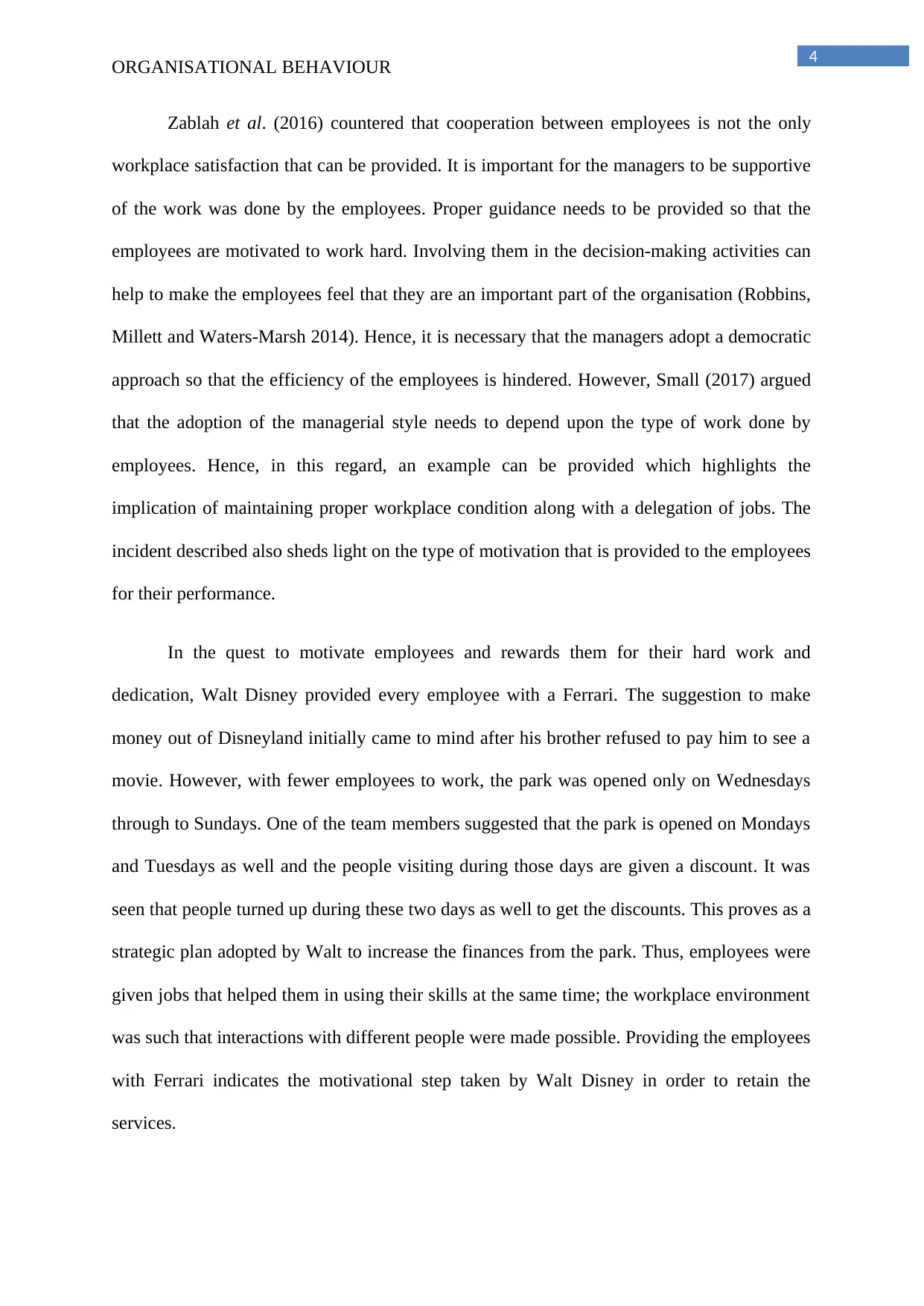
4
ORGANISATIONAL BEHAVIOUR
Zablah et al. (2016) countered that cooperation between employees is not the only
workplace satisfaction that can be provided. It is important for the managers to be supportive
of the work was done by the employees. Proper guidance needs to be provided so that the
employees are motivated to work hard. Involving them in the decision-making activities can
help to make the employees feel that they are an important part of the organisation (Robbins,
Millett and Waters-Marsh 2014). Hence, it is necessary that the managers adopt a democratic
approach so that the efficiency of the employees is hindered. However, Small (2017) argued
that the adoption of the managerial style needs to depend upon the type of work done by
employees. Hence, in this regard, an example can be provided which highlights the
implication of maintaining proper workplace condition along with a delegation of jobs. The
incident described also sheds light on the type of motivation that is provided to the employees
for their performance.
In the quest to motivate employees and rewards them for their hard work and
dedication, Walt Disney provided every employee with a Ferrari. The suggestion to make
money out of Disneyland initially came to mind after his brother refused to pay him to see a
movie. However, with fewer employees to work, the park was opened only on Wednesdays
through to Sundays. One of the team members suggested that the park is opened on Mondays
and Tuesdays as well and the people visiting during those days are given a discount. It was
seen that people turned up during these two days as well to get the discounts. This proves as a
strategic plan adopted by Walt to increase the finances from the park. Thus, employees were
given jobs that helped them in using their skills at the same time; the workplace environment
was such that interactions with different people were made possible. Providing the employees
with Ferrari indicates the motivational step taken by Walt Disney in order to retain the
services.
ORGANISATIONAL BEHAVIOUR
Zablah et al. (2016) countered that cooperation between employees is not the only
workplace satisfaction that can be provided. It is important for the managers to be supportive
of the work was done by the employees. Proper guidance needs to be provided so that the
employees are motivated to work hard. Involving them in the decision-making activities can
help to make the employees feel that they are an important part of the organisation (Robbins,
Millett and Waters-Marsh 2014). Hence, it is necessary that the managers adopt a democratic
approach so that the efficiency of the employees is hindered. However, Small (2017) argued
that the adoption of the managerial style needs to depend upon the type of work done by
employees. Hence, in this regard, an example can be provided which highlights the
implication of maintaining proper workplace condition along with a delegation of jobs. The
incident described also sheds light on the type of motivation that is provided to the employees
for their performance.
In the quest to motivate employees and rewards them for their hard work and
dedication, Walt Disney provided every employee with a Ferrari. The suggestion to make
money out of Disneyland initially came to mind after his brother refused to pay him to see a
movie. However, with fewer employees to work, the park was opened only on Wednesdays
through to Sundays. One of the team members suggested that the park is opened on Mondays
and Tuesdays as well and the people visiting during those days are given a discount. It was
seen that people turned up during these two days as well to get the discounts. This proves as a
strategic plan adopted by Walt to increase the finances from the park. Thus, employees were
given jobs that helped them in using their skills at the same time; the workplace environment
was such that interactions with different people were made possible. Providing the employees
with Ferrari indicates the motivational step taken by Walt Disney in order to retain the
services.
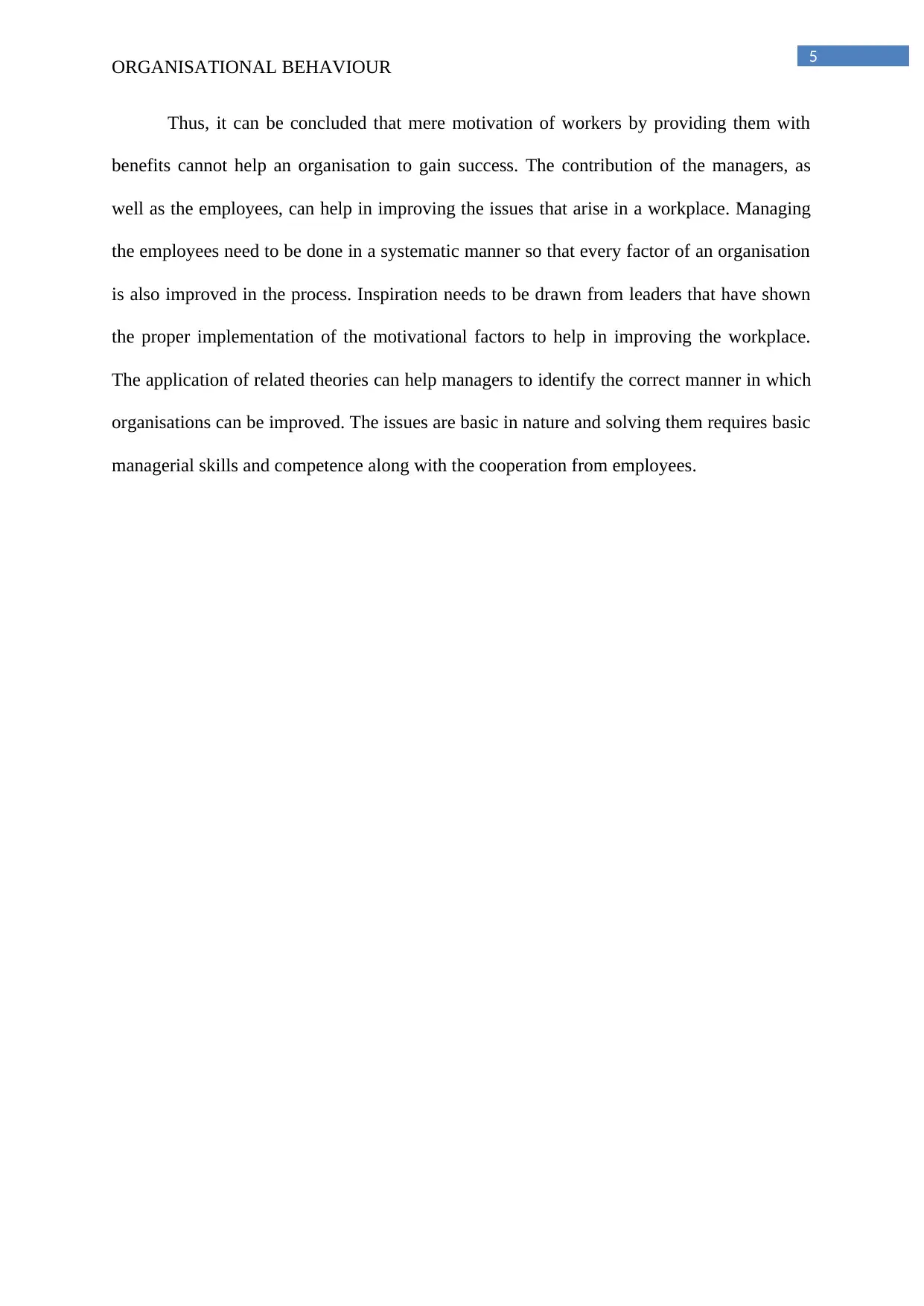
5
ORGANISATIONAL BEHAVIOUR
Thus, it can be concluded that mere motivation of workers by providing them with
benefits cannot help an organisation to gain success. The contribution of the managers, as
well as the employees, can help in improving the issues that arise in a workplace. Managing
the employees need to be done in a systematic manner so that every factor of an organisation
is also improved in the process. Inspiration needs to be drawn from leaders that have shown
the proper implementation of the motivational factors to help in improving the workplace.
The application of related theories can help managers to identify the correct manner in which
organisations can be improved. The issues are basic in nature and solving them requires basic
managerial skills and competence along with the cooperation from employees.
ORGANISATIONAL BEHAVIOUR
Thus, it can be concluded that mere motivation of workers by providing them with
benefits cannot help an organisation to gain success. The contribution of the managers, as
well as the employees, can help in improving the issues that arise in a workplace. Managing
the employees need to be done in a systematic manner so that every factor of an organisation
is also improved in the process. Inspiration needs to be drawn from leaders that have shown
the proper implementation of the motivational factors to help in improving the workplace.
The application of related theories can help managers to identify the correct manner in which
organisations can be improved. The issues are basic in nature and solving them requires basic
managerial skills and competence along with the cooperation from employees.
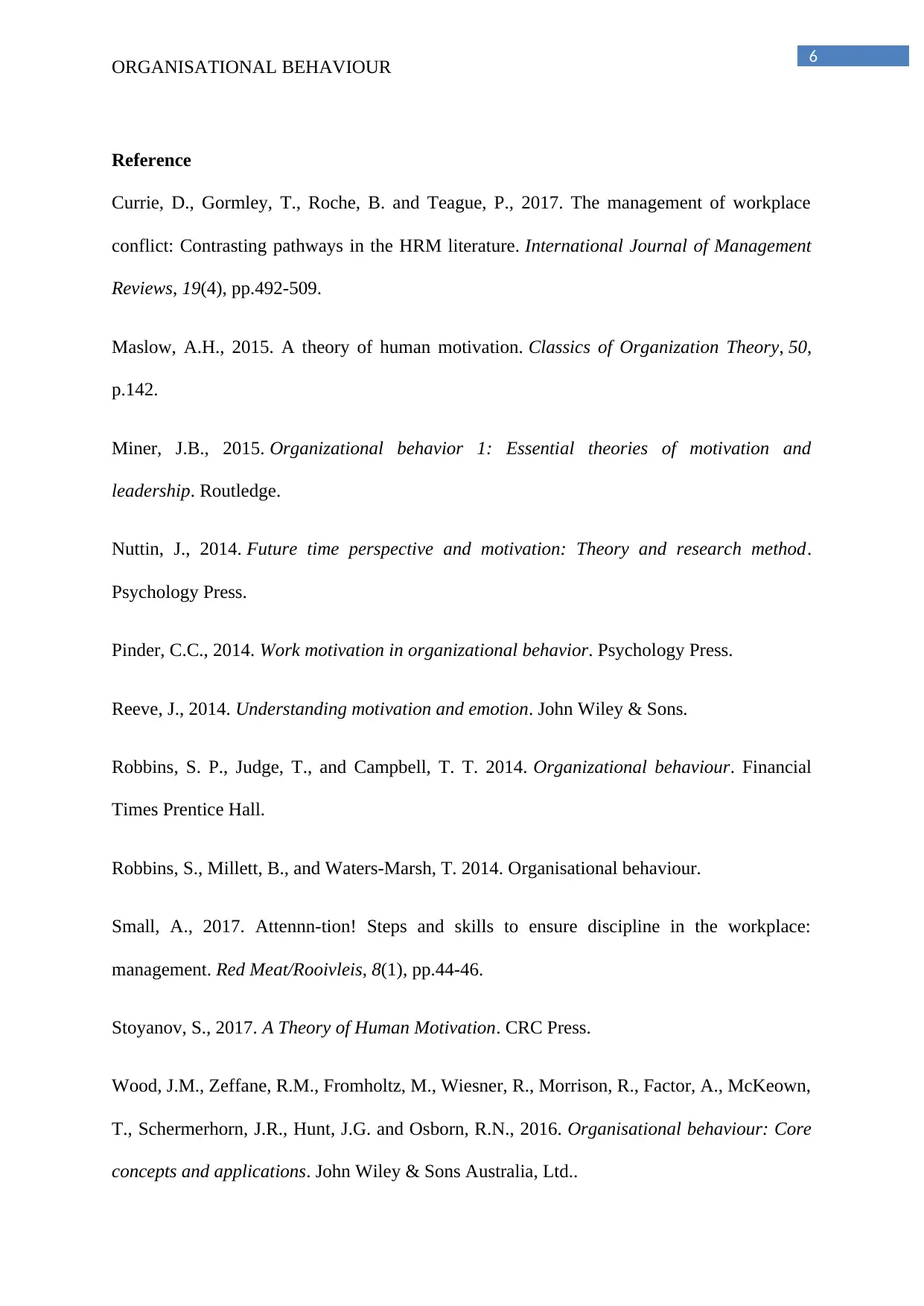
6
ORGANISATIONAL BEHAVIOUR
Reference
Currie, D., Gormley, T., Roche, B. and Teague, P., 2017. The management of workplace
conflict: Contrasting pathways in the HRM literature. International Journal of Management
Reviews, 19(4), pp.492-509.
Maslow, A.H., 2015. A theory of human motivation. Classics of Organization Theory, 50,
p.142.
Miner, J.B., 2015. Organizational behavior 1: Essential theories of motivation and
leadership. Routledge.
Nuttin, J., 2014. Future time perspective and motivation: Theory and research method.
Psychology Press.
Pinder, C.C., 2014. Work motivation in organizational behavior. Psychology Press.
Reeve, J., 2014. Understanding motivation and emotion. John Wiley & Sons.
Robbins, S. P., Judge, T., and Campbell, T. T. 2014. Organizational behaviour. Financial
Times Prentice Hall.
Robbins, S., Millett, B., and Waters-Marsh, T. 2014. Organisational behaviour.
Small, A., 2017. Attennn-tion! Steps and skills to ensure discipline in the workplace:
management. Red Meat/Rooivleis, 8(1), pp.44-46.
Stoyanov, S., 2017. A Theory of Human Motivation. CRC Press.
Wood, J.M., Zeffane, R.M., Fromholtz, M., Wiesner, R., Morrison, R., Factor, A., McKeown,
T., Schermerhorn, J.R., Hunt, J.G. and Osborn, R.N., 2016. Organisational behaviour: Core
concepts and applications. John Wiley & Sons Australia, Ltd..
ORGANISATIONAL BEHAVIOUR
Reference
Currie, D., Gormley, T., Roche, B. and Teague, P., 2017. The management of workplace
conflict: Contrasting pathways in the HRM literature. International Journal of Management
Reviews, 19(4), pp.492-509.
Maslow, A.H., 2015. A theory of human motivation. Classics of Organization Theory, 50,
p.142.
Miner, J.B., 2015. Organizational behavior 1: Essential theories of motivation and
leadership. Routledge.
Nuttin, J., 2014. Future time perspective and motivation: Theory and research method.
Psychology Press.
Pinder, C.C., 2014. Work motivation in organizational behavior. Psychology Press.
Reeve, J., 2014. Understanding motivation and emotion. John Wiley & Sons.
Robbins, S. P., Judge, T., and Campbell, T. T. 2014. Organizational behaviour. Financial
Times Prentice Hall.
Robbins, S., Millett, B., and Waters-Marsh, T. 2014. Organisational behaviour.
Small, A., 2017. Attennn-tion! Steps and skills to ensure discipline in the workplace:
management. Red Meat/Rooivleis, 8(1), pp.44-46.
Stoyanov, S., 2017. A Theory of Human Motivation. CRC Press.
Wood, J.M., Zeffane, R.M., Fromholtz, M., Wiesner, R., Morrison, R., Factor, A., McKeown,
T., Schermerhorn, J.R., Hunt, J.G. and Osborn, R.N., 2016. Organisational behaviour: Core
concepts and applications. John Wiley & Sons Australia, Ltd..
Paraphrase This Document
Need a fresh take? Get an instant paraphrase of this document with our AI Paraphraser
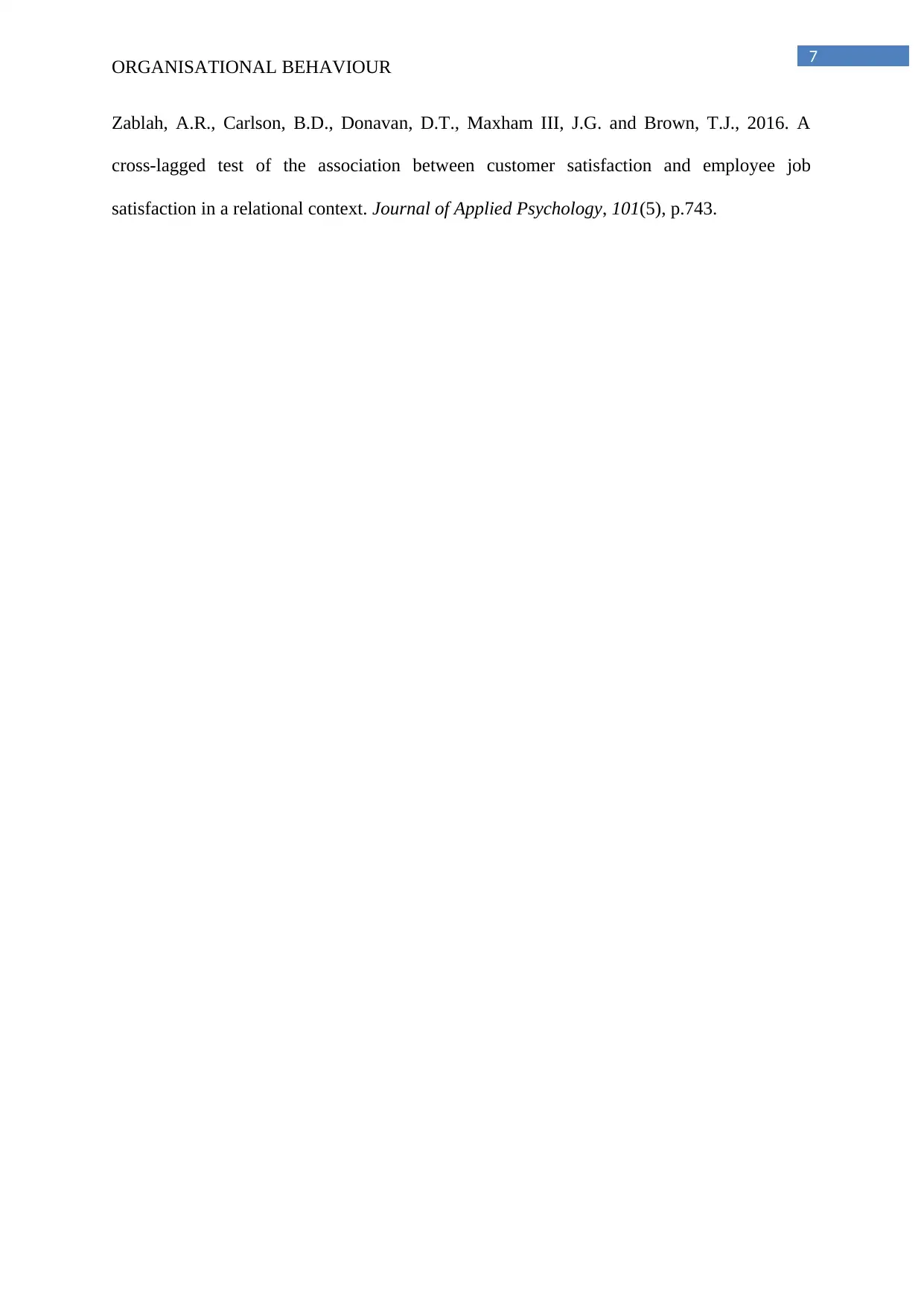
7
ORGANISATIONAL BEHAVIOUR
Zablah, A.R., Carlson, B.D., Donavan, D.T., Maxham III, J.G. and Brown, T.J., 2016. A
cross-lagged test of the association between customer satisfaction and employee job
satisfaction in a relational context. Journal of Applied Psychology, 101(5), p.743.
ORGANISATIONAL BEHAVIOUR
Zablah, A.R., Carlson, B.D., Donavan, D.T., Maxham III, J.G. and Brown, T.J., 2016. A
cross-lagged test of the association between customer satisfaction and employee job
satisfaction in a relational context. Journal of Applied Psychology, 101(5), p.743.
1 out of 8
Related Documents
Your All-in-One AI-Powered Toolkit for Academic Success.
+13062052269
info@desklib.com
Available 24*7 on WhatsApp / Email
![[object Object]](/_next/static/media/star-bottom.7253800d.svg)
Unlock your academic potential
© 2024 | Zucol Services PVT LTD | All rights reserved.





